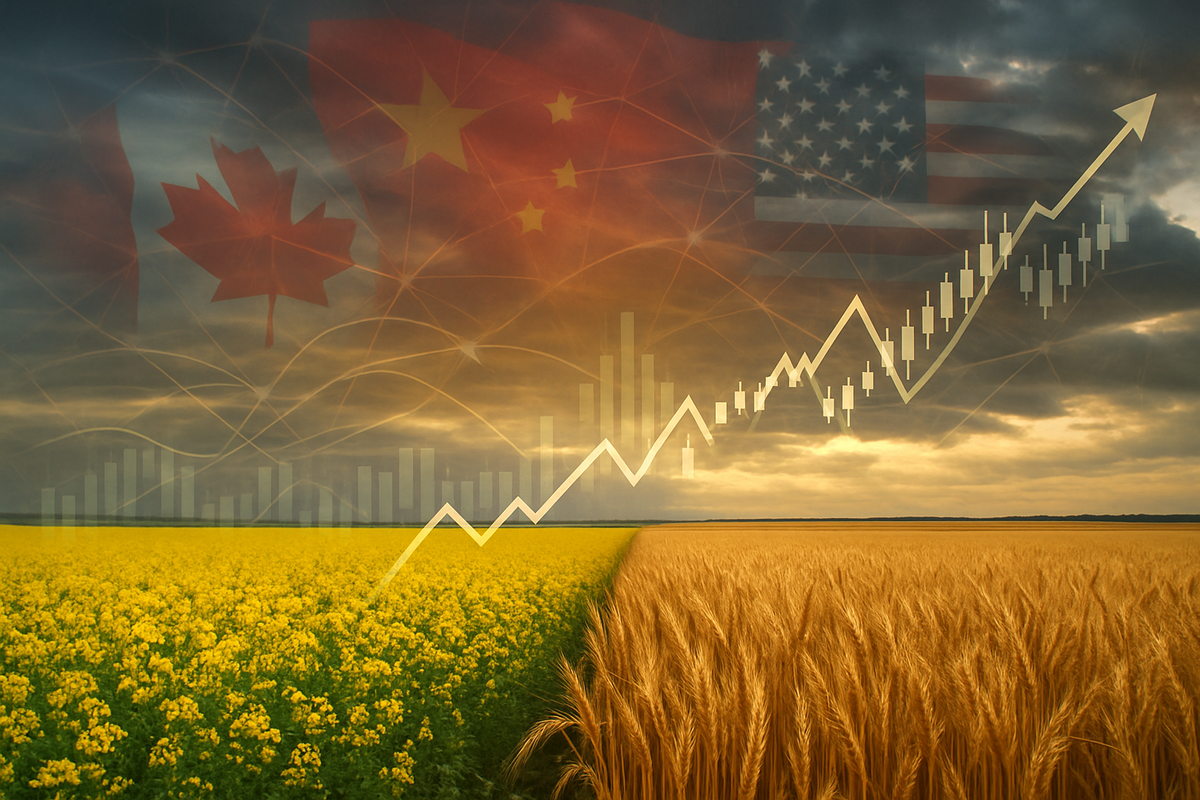
October 14, 2025, marked a day of modest upward movement in key agricultural commodities, with Canola and Wheat contracts showing gains as markets closed. As reported by GX94 Radio, the November Canola contract rose to 615.60, up 8.20, while the January contract followed suit, climbing to 630.10, an increase of 7.50. Minneapolis Wheat also saw a slight uptick, with its December contract reaching 5.53 1/2, up 2 points. These movements occur against a backdrop of persistent geopolitical tensions, particularly concerning tariffs impacting Canola sales to major markets like the United States and China, suggesting that while prices are rising, underlying market stability remains fragile.
The immediate implications of these price shifts are multifaceted. For producers, particularly in regions like Alberta where the harvest is largely complete, the higher closing prices offer a welcome boost to potential revenues. However, the broader market narrative is heavily influenced by ongoing trade disputes, which continue to cast a shadow over future demand and export opportunities. The slight increases in Wheat prices, while less dramatic, reflect a similar dynamic of cautious optimism tempered by global economic uncertainties and supply chain considerations. The coming weeks will likely see continued close monitoring of international trade negotiations and their potential to either alleviate or exacerbate current market pressures.
Detailed Market Dynamics and Geopolitical Undercurrents
The modest gains observed in Canola and Wheat futures on October 14, 2025, reflect a complex interplay of supply dynamics, robust harvest outcomes, and persistent geopolitical pressures. The November Canola contract closed at 615.60, up 8.20, while the January contract saw an increase of 7.50 to 630.10. Similarly, Minneapolis Wheat's December contract edged up 2 points to 5.53 1/2. These movements, while positive, occur within a volatile landscape shaped significantly by international trade relations.
A crucial timeline of events underscores the current market sentiment, particularly for Canola. The Canadian canola industry has been navigating substantial trade headwinds, primarily from China. In October 2024, Canada imposed a 100 percent tariff on Chinese electric vehicles, which triggered retaliatory measures from Beijing. Effective March 20, 2025, China levied a 100 percent tariff on Canadian canola oil and meal, followed by a 75.8 percent tariff on Canadian canola seed imports starting August 14, 2025. These tariffs have had a devastating impact, effectively closing China, once Canada's second-largest canola market, to Canadian exports. Market analysts like Chuck Penner estimated losses in the hundreds of millions for Canadian farmers due to these tariffs. While the United States initially threatened tariffs on Canadian goods in early 2025, it later exempted CUSMA-compliant canola products in April, offering some relief but not entirely alleviating the "unprecedented trade uncertainty" faced by the industry.
Amidst these trade disputes, the agricultural sector is also contending with significant supply-side factors. In Alberta, a key agricultural province, the harvest for all crops was 96 percent complete by October 7, 2025, ahead of historical averages. The canola harvest specifically reached 92 percent completion by the same date, six points above its five-year average. Crucially, provincial yield estimates for major crops, including canola, are robust, exceeding the five-year average by more than 25 percent, with canola yields at 42.6 bushels per acre and 93 percent grading No. 1. This strong production ensures an abundant supply for the current season, which could temper price increases despite demand-side challenges.
Key players and stakeholders involved in these dynamics include Canadian farmers and agricultural producers, the Canadian government advocating for its industry, and the governments of China and the United States, whose trade policies have direct and significant impacts. Furthermore, agricultural ministers from Canada, the U.S., and Mexico are set to convene at the Tri-National Agricultural Accord in Morelia, Mexico, from October 16-18, 2025. This summit aims to strengthen trilateral cooperation and prepare for the 2026 CUSMA Review, highlighting the ongoing efforts to maintain and improve North American agricultural trade relations in a globally competitive and often contentious environment. The initial market reaction to these combined factors sees futures contracts showing slight gains, suggesting that robust supply and ongoing diplomatic efforts are providing some counterweight to the severe impact of Chinese tariffs.
Corporate Fortunes in the Balance: Winners and Losers in a Volatile Market
The fluctuating commodity prices and persistent trade disputes create a complex landscape for public companies operating within the agricultural sector. While rising prices for Canola and Wheat might initially appear beneficial, the underlying tariff environment introduces significant challenges, creating both potential winners and losers among key industry players.
Companies deeply entrenched in agricultural processing and trading, such as Archer Daniels Midland Company (NYSE: ADM) and Bunge Global SA (NYSE: BG), face a dual impact. On one hand, the upward trend in Canola and Wheat prices could lead to increased revenues from the sale of processed products like canola oil and meal, or various wheat flours. Both ADM and Bunge have extensive global operations in oilseed crushing and grain trading, and Bunge's impending merger with Viterra is set to bolster its grain buying capacity, particularly in Canada. However, these companies also face higher procurement costs for raw commodities. Their profitability will hinge on their crushing margins and their ability to effectively pass on increased input costs to consumers. The severe tariffs imposed by China on Canadian canola, which have effectively closed off a major market, could limit the volume of Canadian canola available for processing and trading, forcing these companies to adjust their sourcing strategies and potentially impacting overall sales volumes and profitability.
Conversely, agricultural input suppliers like Nutrien Ltd. (TSX: NTR) and Corteva, Inc. (NYSE: CTVA) could see indirect benefits. Nutrien, a leading provider of fertilizers and other crop inputs, and Corteva, a major seed and crop protection company, rely on farmer profitability and planting decisions. Higher commodity prices for Canola and Wheat incentivize farmers to maximize yields, potentially increasing demand for Nutrien's fertilizers and Corteva's advanced seeds and crop protection products. This could translate into stronger revenues for these input providers, assuming farmers' financial health isn't severely undermined by other factors, such as consistently high input costs that erode their margins even with slightly better commodity prices. Corteva's collaboration with Bunge and Chevron on winter canola hybrids for renewable fuels also presents a new revenue stream, capitalizing on growing demand for sustainable solutions.
The shadow of tariffs, particularly China's punitive duties on Canadian canola, casts a long-term risk for all stakeholders. While the US exempted CUSMA-compliant Canadian canola from its own tariff threats, the Chinese market closure has led to significant export declines and depressed cash prices for Canadian farmers. This situation not only impacts the direct exporters but also creates a ripple effect throughout the supply chain, potentially influencing planting decisions for future seasons and the overall availability of canola for global processors. The ability of these companies to navigate such trade barriers, adapt their supply chains, and explore new markets will be crucial in determining their long-term financial health and stock performance in this increasingly interconnected and politically charged agricultural market.
Wider Significance: A Confluence of Geopolitics, Climate, and Supply Chain Pressures
The modest uptick in Canola and Wheat prices on October 14, 2025, is merely a surface ripple in a vast and turbulent ocean of global agricultural trends. The wider significance of these movements lies in their intersection with escalating geopolitical tensions, the undeniable impact of climate change, and persistent supply chain vulnerabilities, all of which are reshaping the future of food and agriculture.
Global trade dynamics, characterized by heightened protectionism and strategic stockpiling, are a dominant force. The ongoing Russia-Ukraine conflict continues to destabilize the Black Sea region, a critical source of global wheat exports, contributing to price volatility despite forecasts of record global wheat production for 2025/26. For Canola, the market is navigating a peculiar paradox: robust Canadian harvests are juxtaposed with severe trade restrictions. China's retaliatory tariffs have significantly hampered profitable export avenues for Canadian canola, leading to a projected 45% fall in Chinese imports of canola/rapeseed in 2025. This forces Canada to seek alternative markets and creates a domestic oversupply pressure. However, surging global demand for vegetable oils, particularly for renewable fuels and sustainable aviation fuel, driven by decreases in sunflower seed and rapeseed supplies, presents a bullish demand scenario for canola oil, creating a complex and somewhat contradictory market environment.
Climate change stands as the most profound long-term risk. Rising temperatures, erratic rainfall, and more frequent droughts are directly impacting crop yields and increasing price volatility. Wheat, being highly sensitive to heat stress, faces potential yield reductions of 6-10% for every 1°C rise during critical growth phases. While some temperate regions might see increased land suitable for wheat, the overall trend points to greater instability. For canola, similar vulnerabilities to drought and extreme heat exist, affecting both yields and oil content. The swift harvest completion in Alberta, while positive for current supply, is tempered by concerns over well-below-average surface soil moisture, highlighting the critical need for significant precipitation before winter freeze-up to secure the 2026 crop. These climatic shifts demand adaptive farming practices and resilient crop varieties to safeguard future food security.
The agricultural supply chain remains fragile, plagued by global fuel price volatility, infrastructure gaps, and increased input costs. Fertilizer prices, for instance, are projected to rise by 7% in 2025 due to strengthening demand and geopolitical tensions. These elevated input costs, coupled with potential tariffs on agricultural goods between major trading partners, squeeze farmers' margins and increase the overall cost of production. The ripple effects extend to food processors and animal feed industries, which face higher input costs for wheat and canola, potentially leading to increased consumer prices. The biofuels sector, however, stands to benefit from the strong demand for canola oil, which could drive up prices, creating a competitive dynamic for the commodity. Historically, periods of high commodity price volatility and trade disruptions, such as the agricultural depressions of the 1920s and 1980s, serve as stark reminders of the severe economic hardship that can befall farmers and the broader agricultural sector when market forces and policy decisions align negatively. The current situation, while different in its specifics, echoes the need for resilient infrastructure, diversified trade partners, and international cooperation to mitigate risks.
What Comes Next: Navigating a Future of Volatility and Adaptation
The path forward for agricultural commodities, particularly Canola and Wheat, is paved with both challenges and opportunities, demanding strategic pivots and innovative adaptations from the industry. In the short-term (2025-2026), the market is likely to remain volatile, influenced by abundant global supplies and ongoing geopolitical uncertainties.
For Wheat, the expectation of another record global grain harvest in 2025/26, with production projected to reach an all-time high, suggests continued price pressure, potentially near five-year lows. Despite this, global wheat shipments are projected to rebound, driven by expanding food demand in Asia and Africa. However, geopolitical tensions, especially the lingering effects of the Russia-Ukraine conflict, will remain a critical factor influencing price fluctuations. Canola faces similar short-term pressures from anticipated global oversupply due to strong harvests in Canada, Australia, and Russia. Persistent trade disruptions, notably China's tariffs on Canadian canola, will continue to cap substantial price rallies, forcing Canadian producers to seek market diversification beyond traditional partners.
Looking further ahead, beyond 2026, agricultural commodity prices are generally projected to decline gradually, driven by improved supplies and a slowdown in global economic growth. However, this outlook is highly uncertain. Climate change will increasingly dictate agricultural productivity, with warmer temperatures potentially extending growing seasons in northern regions for wheat, but also bringing more frequent extreme weather events that threaten yields. A significant long-term trend is the increasing global use of vegetable oils for biofuels, which could provide a robust demand floor and reshape the market for canola and other oilseeds. This demand, particularly from the U.S. biofuel sector, presents a strong market opportunity, though policy uncertainty remains a factor.
To navigate this complex future, the agricultural industry must undertake several strategic pivots. Market diversification is paramount for canola, with Canada actively exploring new export avenues in the EU, India, and Southeast Asia to mitigate risks from trade disputes. Investing in value-added processing, such as converting canola into oil for fuel and protein, will be crucial for long-term resilience. Technology adoption, including AI, precision farming, and bioengineering for climate-resilient crops, will be essential for optimizing operations and enhancing sustainability. Furthermore, proactive marketing strategies, setting clear price targets, and acting decisively in volatile markets will be vital for farmers to maintain profitability amidst rising input costs, particularly for fertilizers.
The interplay of geopolitical events, economic conditions, and climate change will continue to drive significant volatility and shape future market outcomes. Potential scenarios range from an "Abundant Supply, Low Price" scenario, where large harvests keep prices subdued, to a "Biofuel-Driven Recovery" for canola, or even "Geopolitical Disruption" and "Climate Extremes" scenarios, which could lead to sudden price spikes and severe supply chain challenges. The industry's ability to adapt to these evolving dynamics through innovation, diversification, and resilient supply chains will determine its success in the coming years.
Wrap-up: Navigating a New Era in Agricultural Markets
The October 14, 2025, closing commodity prices for Canola and Wheat offer a snapshot of an agricultural market in flux, characterized by modest price gains amidst significant underlying tensions. The key takeaways from this period underscore the profound impact of geopolitical trade disputes, particularly China's tariffs on Canadian canola, which have severely disrupted traditional market flows. Simultaneously, robust harvests in key regions like Alberta signal ample supply, creating a delicate balance between supply-side abundance and demand-side constraints exacerbated by trade barriers.
Moving forward, the agricultural market is poised for continued volatility. While strong global production forecasts for both wheat and canola suggest a tendency towards lower prices in the short term, the growing demand for vegetable oils in the biofuel sector presents a compelling long-term opportunity for canola. Investors and stakeholders should closely monitor the ongoing Tri-National Agricultural Accord for potential breakthroughs in North American trade relations, as well as any developments regarding the Canada-China tariff dispute. The ability of public companies like Archer Daniels Midland Company (NYSE: ADM), Bunge Global SA (NYSE: BG), Nutrien Ltd. (TSX: NTR), and Corteva, Inc. (NYSE: CTVA) to adapt their supply chains, diversify markets, and invest in value-added processing and sustainable technologies will be crucial for their resilience and profitability.
Ultimately, the significance of these events lies in their contribution to a new era for agricultural markets – one where climate resilience, technological innovation, and agile trade strategies are not merely advantageous but essential for survival. What investors should watch for in the coming months are signs of resolution in trade disputes, the stability of biofuel policies, and the industry's progress in adopting sustainable practices to ensure long-term food security and market stability.
This content is intended for informational purposes only and is not financial advice






